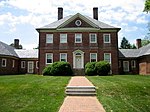Beltsville Information Management Center
1980s establishments in MarylandBeltsville, MarylandBuildings and structures in Prince George's County, MarylandGovernment buildings in MarylandSecret broadcasting ... and 3 more
Secret places in the United StatesUnited States Agency for International DevelopmentUnited States Department of State

The Beltsville Information Management Center (BIMC), formerly named the Beltsville Messaging Center (BMC) and the Beltsville Communications Center (also known as the Beltsville Communications Annex), is a United States Department of State facility located in Beltsville, Maryland, next door to the U.S. Special Collection Service (SCS). It serves as the primary relay facility for the Diplomatic Telecommunications Service and services the communications needs of various U.S. government programs and agencies, including the SCS.
Excerpt from the Wikipedia article Beltsville Information Management Center (License: CC BY-SA 3.0, Authors, Images).Beltsville Information Management Center
Odell Road,
Geographical coordinates (GPS) Address Nearby Places Show on map
Geographical coordinates (GPS)
| Latitude | Longitude |
|---|---|
| N 39.046 ° | E -76.864 ° |
Address
Odell Road
20705
Maryland, United States
Open on Google Maps







